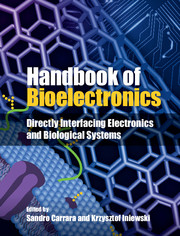1 - What is bioelectronics?
Published online by Cambridge University Press: 05 September 2015
Summary
Although the term was first proposed in 1968, the birth of bioelectronics as we know it today is much more recent. In fact, the first meaning of the word bioelectronics was the intermolecular electron transfer found in biological systems [1], while its modern meaning is quite different, as discussed in this chapter.
Tony Turner, founder and Editor-in-Chief of the Elsevier journal Biosensors and Bioelectronics, wrote in 2005: “Bioelectronics is a recently coined term for a field of research that works to establish a synergy between electronics and biology” [2]. Over the years, his journal became the main forum in the field of bioelectronics. The journal originally appeared in 1985 with the simple name of Biosensors, and the title was expanded to include the term Bioelectronics in 1992 [2]. The expressed scope of the journal [3] explains that a key aspect of bioelectronics is the interface between biological materials and electronics.
To better understand the modern state of the field, we can also consider the meaning of “advanced bioelectronics” as mentioned in April 2013 by the National Institute of Standards and Technology (NIST – an agency of the US Department of Commerce) and represented by the example of electronic DNA sequencing, as supported by singlemolecule mass spectrometry to develop innovative electronic devices for healthcare [4]. The authors [4] refer to devices in which an electric field drives individual molecules of single-stranded DNA through a nanometer-scale pore (Figure 1.1). That approach is a step toward applications for rapid sequencing of DNA [5] and DNA transcription complexes [6], and could lead to further developments in protein sequencing [7] too. The application is clearly focused on devices for healthcare and, more generally, includes both diagnostic and therapeutic tools.
- Type
- Chapter
- Information
- Handbook of BioelectronicsDirectly Interfacing Electronics and Biological Systems, pp. 1 - 4Publisher: Cambridge University PressPrint publication year: 2015
References
- 1
- Cited by



